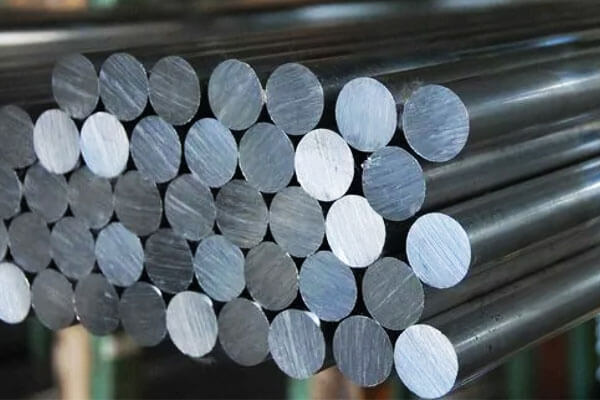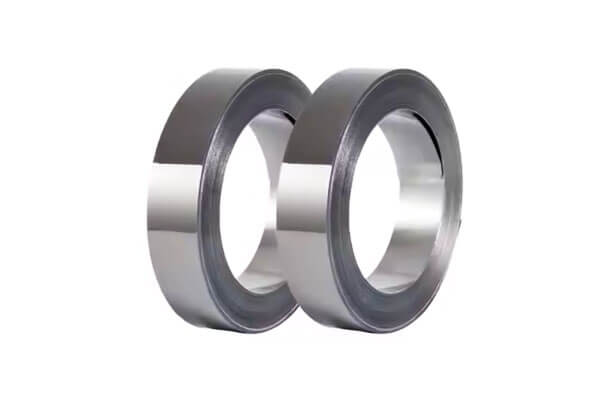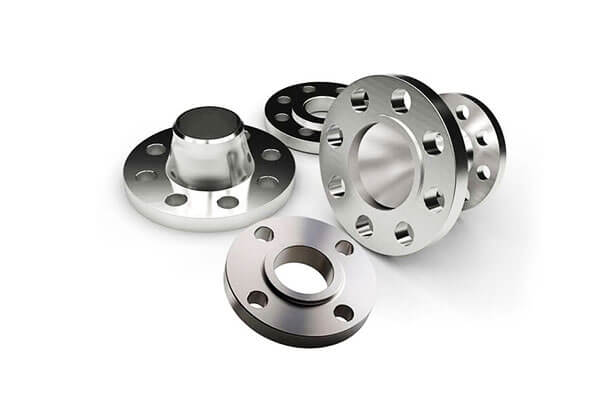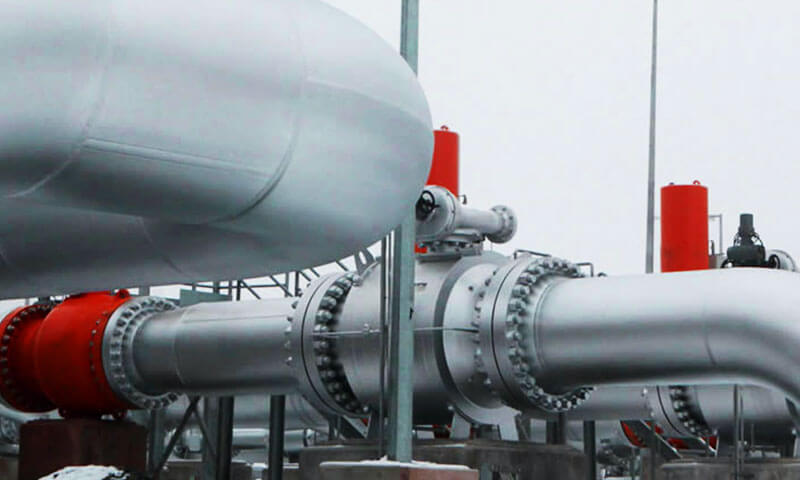1. Pengenalan
Nickel-based alloys have long been the foundation of high-performance materials used in extreme environments.
Keupayaan mereka untuk bertahan suhu tinggi, pengoksidaan, dan tekanan mekanikal makes them indispensable in Aeroangkasa, penjanaan kuasa, dan aplikasi perindustrian.
Di antara aloi ini, Aloi nikel 75 (2.4951) has earned a reputation for its exceptional thermal stability, Rintangan Creep, dan rintangan kakisan
Originally developed in the 1940s for the Whittle jet engine turbine blades, this alloy has continued to prove its reliability and versatility merentasi pelbagai industri.
Its unique combination of kekuatan mekanikal, Kestabilan terma, dan kemudahan fabrikasi makes it an attractive choice for applications requiring long-term durability in high-temperature environments.
Artikel ini menyediakan in-depth technical analysis of Nickel Alloy 75 (2.4951), covering:
- Chemical composition and microstructure, explaining how each element contributes to its superior properties.
- Fizikal, haba, and mechanical characteristics, detailing its performance under extreme conditions.
- Manufacturing techniques and processing challenges, highlighting the best fabrication methods.
- Industrial applications and economic feasibility, demonstrating its widespread use.
- Future trends and technological advancements, exploring the next phase of alloy development.
By the end of this discussion, readers will have a comprehensive understanding of Alloy 75 and why it remains a preferred material for demanding engineering applications.
2. Komposisi kimia dan struktur mikro
Primary Constituents and Their Functions
Aloi nikel 75 (2.4951) adalah a nickel-chromium alloy Direka untuk moderate high-temperature applications.

The following table outlines its key alloying elements and their contributions to material performance:
| Elemen | Komposisi (%) | Fungsi |
|---|---|---|
| Nikel (Dalam) | Keseimbangan (~75.0%) | Provides oxidation and corrosion resistance, ensures thermal stability. |
| Chromium (Cr) | 18.0-21.0% | Enhances oxidation and scaling resistance, strengthens the alloy. |
| Titanium (Dari) | 0.2–0.6% | Stabilizes carbides, improves high-temperature strength. |
| Karbon (C) | 0.08-0.15% | Forms carbides to enhance hardness and creep resistance. |
| Besi (Fe) | ≤5.0% | Adds mechanical strength without compromising corrosion resistance. |
| Silikon (Dan), Mangan (Mn), Tembaga (Cu) | ≤1.0%, ≤1.0%, ≤0.5% | Provide minor processing benefits and oxidation resistance. |
Analisis mikrostruktur
- The FCC (Padu berpusatkan muka) struktur kristal ensures high ductility and fracture toughness, which is essential for thermal cycling applications.
- Titanium and carbon form carbides (Tic, Cr₇c₃), significantly increasing the alloy’s creep strength at elevated temperatures.
- Microscopic examination (Yang, TEM, and XRD analysis) confirms that uniform grain structures contribute to improved fatigue resistance.
3. Physical and Thermal Properties
Basic Physical Properties
- Ketumpatan: 8.37 g/cm³
- Julat lebur: 1340-1380 ° C.
- Resistiviti elektrik: 1.09 mm²/m (higher than stainless steel, making it ideal for heating elements)
Thermal Characteristics
| Harta | Nilai | Makna |
|---|---|---|
| Kekonduksian terma | 11.7 W/m·°C | Ensures efficient heat dissipation in high-temperature environments. |
| Kapasiti haba tertentu | 461 J/kg·°C | Improves thermal stability. |
| Pekali pengembangan haba (Cte) | 11.0 μm/m · ° C. (20-100 ° C.) | Maintains structural integrity under thermal cycling. |
Oxidation Resistance and Thermal Stability
- Sustains oxidation resistance up to 1100°C, making it ideal for gas turbines and exhaust systems.
- Maintains mechanical strength under prolonged high-temperature exposure, reducing the risk of deformation.
Sifat magnet
- Low magnetic permeability (1.014 pada 200 Oersted) ensures suitability for applications requiring minimal electromagnetic interference.
4. Mechanical Properties and High-Temperature Performance of Nickel Alloy 75
This section provides a comprehensive analysis of Nickel Alloy 75 sifat mekanikal, behavior under extreme conditions, and testing methodologies to evaluate its long-term performance.
Kekuatan tegangan, Kekuatan hasil, and Elongation
Tensile properties define the alloy’s ability to withstand static and dynamic loading without experiencing permanent deformation or failure.
Aloi nikel 75 mengekalkan high tensile strength and reasonable ductility across a wide temperature range.

Key Tensile Properties
| Suhu (° C.) | Kekuatan tegangan (MPA) | Kekuatan hasil (MPA) | Pemanjangan (%) |
|---|---|---|---|
| Room Temp (25° C.) | ~ 600 | ~ 275 | ~40 |
| 760° C. | ~380 | ~190 | ~ 25 |
| 980° C. | ~ 120 | ~ 60 | ~10 |
Pemerhatian:
- High strength at room temperature ensures excellent load-bearing capacity.
- Gradual reduction in tensile strength with increasing temperature is expected due to softening effects.
- Ductility remains sufficient at elevated temperatures, allowing for stress redistribution without brittle failure.
These properties make Aloi nikel 75 suitable for components exposed to high temperatures and mechanical stress, seperti bilah turbin, exhaust ducts, and heat exchanger parts.
Creep Resistance and Long-Term Load Stability
Creep is a critical factor for materials used in Aplikasi suhu tinggi yang berterusan. It refers to the slow, time-dependent deformation under constant stress.
The ability to resist creep determines the longevity and reliability aloi 75 in extreme environments.
Creep Performance Data
| Suhu (° C.) | Tekanan (MPA) | Time to 1% Creep Strain (hrs) |
|---|---|---|
| 650° C. | 250 | ~10,000 |
| 760° C. | 150 | ~8,000 |
| 870° C. | 75 | ~5,000 |
Wawasan Utama:
- Strong creep resistance at moderate temperatures (650–760°C) extends component lifespan in jet engines and power plant turbines.
- At 870°C, creep rate increases significantly, requiring careful design considerations for prolonged exposure.
- Aloi 75 outperforms conventional stainless steels, making it a more reliable choice for high-temperature engineering applications.
To further enhance creep resistance, manufacturers often optimize grain size and perform controlled heat treatments, memastikan microstructural stability during prolonged use.
Fatigue Strength and Fracture Toughness
Fatigue Resistance Under Cyclic Loading
It is a major concern in components subjected to repeated thermal cycling and mechanical stress, such as those in aerospace propulsion systems and gas turbines.
Aloi 75 pameran strong fatigue resistance, preventing premature failure due to cyclic loading.
| Suhu (° C.) | Stress Amplitude (MPA) | Cycles to Failure (x10⁶) |
|---|---|---|
| Room Temp (25° C.) | 350 | ~10 |
| 650° C. | 250 | ~6 |
| 760° C. | 180 | ~4 |
Fracture Mechanics and Crack Propagation
Nickel Alloy 75’s fracture toughness is relatively high, mencegah catastrophic failure due to crack initiation and propagation.
Walau bagaimanapun, microstructural defects, pemendakan karbida, and prolonged thermal exposure can influence crack growth rates.
- Intergranular and transgranular fracture modes have been observed in fatigue testing, bergantung pada temperature and stress levels.
- Optimized grain boundary strengthening techniques (via controlled cooling rates and minor alloying additions) bertambah baik crack resistance.
Thermal Stability and Oxidation Resistance
Aloi nikel 75 direka untuk oxidation resistance up to 1100°C, making it suitable for components in combustion environments and high-temperature reactors.
Key Thermal Properties
| Harta | Nilai | Makna |
|---|---|---|
| Kekonduksian terma | 11.7 W/m·°C | Allows heat dissipation in high-temperature applications. |
| Kapasiti haba tertentu | 461 J/kg·°C | Ensures thermal stability. |
| Oxidation Limit | 1100° C. | Provides excellent surface protection. |
| Pekali pengembangan haba (20-100 ° C.) | 11.0 μm/m · ° C. | Reduces thermal stress during heating and cooling cycles. |
Oxidation and Surface Stability
- Chromium (18–21%) forms a stable oxide layer, protecting the alloy from high-temperature degradation.
- Low sulfur and phosphorus content minimizes embrittlement in thermal cycling applications.
- Compatible with thermal barrier coatings (TBCS) and aluminized coatings to further enhance oxidation resistance.
5. Manufacturing and Processing Technologies of Nickel Alloy 75
Nickel Alloys – Alloy 75 is widely used in high-temperature applications,
necessitating precise manufacturing and processing techniques to maintain its integriti mekanikal, Kestabilan terma, and oxidation resistance.
This section explores the primary fabrication methods, heat treatment procedures, cabaran kimpalan,
and surface finishing technologies that enhance the alloy’s performance in demanding environments.
Primary Fabrication Techniques
Manufacturing Nickel Alloy 75 components involves Casting, menunaikan, bergulir, dan pemesinan, each with specific benefits depending on the application.
Casting
- Pelaburan Pelaburan is commonly used to produce complex aerospace components, bilah turbin, and exhaust parts.
- Sand casting and centrifugal casting are preferred for large-scale industrial furnace and heat exchanger components.
- Cabaran: High-temperature solidification can lead to keliangan pengecutan, memerlukan precision control of cooling rates.
Menempuh dan bergulir
- Hot forging enhances grain structure and mechanical properties, menjadikannya sesuai untuk load-bearing components.
- Cold rolling is used to manufacture thin sheets and strips, memastikan uniform thickness and surface finish.
- Faedah:
-
- Menapis struktur bijirin → Improves mechanical strength.
- Reduces internal defects → Enhances fatigue resistance.
- Enhances workability → Prepares alloy for subsequent machining.
Machining Characteristics
Aloi nikel 75 presents sederhana pemesinan difficulty disebabkan olehnya high work hardening rate and toughness.
| Machining Property | Effect on Processing |
|---|---|
| Kerja pengerasan | Cutting speeds must be optimized to minimize tool wear. |
| Kekonduksian terma (Rendah) | Generates excessive heat during machining. |
| Chip Formation | Requires sharp cutting tools with high thermal resistance. |
Best Machining Practices:
- Gunakan alat pemotongan karbida atau seramik to handle the alloy’s toughness.
- Bekerja high-pressure coolant systems to manage heat buildup.
- Mengoptimumkan pemotongan kelajuan (30-50 m/i) and feed rates to prevent work hardening.

Heat Treatment and Thermal Processing
Heat treatment significantly influences the sifat mekanikal, stress resistance, and microstructural stability of Nickel Alloy 75.
Key Heat Treatment Processes
| Proses | Suhu (° C.) | Tujuan |
|---|---|---|
| Penyepuhlindapan | 980–1065°C | Melembutkan bahan, melegakan tekanan, and improves workability. |
| Rawatan penyelesaian | 980–1080°C | Dissolves carbide precipitates, homogenizes the microstructure. |
| Penuaan | 650–760°C | Enhances creep resistance and high-temperature strength. |
Heat Treatment Advantages:
- Improves grain refinement, enhancing fatigue strength.
- Reduces internal residual stresses, minimizing distortion in components.
- Meningkatkan rintangan merayap, ensuring longevity in high-temperature applications.
Welding and Joining Procedures
Aloi nikel 75 can be welded using various methods, tetapi controlling heat input and preventing carbide precipitation is crucial for maintaining mechanical integrity.
Cabaran kimpalan:
- Cracking Risk: High thermal expansion increases residual stress and hot cracking susceptibility.
- Oxidation Sensitivity: Memerlukan inert gas shielding (Argon, Helium) to prevent surface contamination.
- Pemendakan karbida: Excessive heat input can lead to carbide formation, reducing ductility and toughness.
Kaedah kimpalan yang disyorkan:
| Proses kimpalan | Kelebihan | Cabaran |
|---|---|---|
| Kimpalan TIG (GTAW) | Kawalan yang tepat, minimal heat input | Slower than MIG, requires skilled operation. |
| Kimpalan mig (Gawn) | Pemendapan lebih cepat, good for thick sections | Higher heat input may lead to carbide precipitation. |
| Kimpalan rasuk elektron (EMS) | Penembusan dalam, Penyimpangan terma minimum | High equipment cost. |
✔ Amalan terbaik: Rawatan haba pasca kimpalan (Pwht) pada 650–760°C ke relieve residual stress and prevent cracking.
Rawatan permukaan dan lapisan
Rawatan permukaan bertambah baik rintangan pengoksidaan, Rintangan kakisan, and mechanical wear resistance, especially for components in persekitaran yang melampau.
Oxidation-Resistant Coatings
- Aluminizing: Forms a protective Al₂O₃ layer, Meningkatkan oxidation resistance up to 1100°C.
- Thermal Barrier Coatings (TBCS): Yttria-stabilized zirconia (YSZ) coatings provide Penebat haba in jet engines.
Perlindungan kakisan
- Electropolishing: Enhances surface smoothness, reducing stress concentrators.
- Penyaduran nikel: Improves corrosion resistance in marine and chemical processing applications.
Wear-Resistant Coatings
- Plasma Spray Coatings: Menambah a ceramic or carbide layer, reducing surface degradation in Persekitaran geseran tinggi.
- Ion nitriding: Hardens the surface for better wear and fatigue resistance.
✔ Amalan terbaik: Selecting coatings based on operating environment (suhu, tekanan mekanikal, dan pendedahan kimia) ensures maximum durability.
Quality Control and Testing Methods
To maintain high performance and reliability, Aloi nikel 75 components undergo strict quality control procedures.
Ujian tidak merosakkan (Ndt)
- X-ray Inspection: Detects internal porosity and voids in cast or welded components.
- Ujian ultrasonik (Ut): Evaluates subsurface defects without damaging the material.
- Pemeriksaan penembus pewarna (Dpi): Identifies surface cracks in turbine blades and aerospace parts.
Analisis mikrostruktur
- Scanning Electron Microscopy (Yang): Examines grain boundaries and carbide distribution.
- X-ray Diffraction (XRD): Determines phase composition and crystallographic changes selepas rawatan haba.
Ujian mekanikal
- Ujian tegangan (ASTM E8): Measures yield strength, kekuatan tegangan muktamad, dan pemanjangan.
- Ujian kekerasan (Rockwell, Vickers): Evaluates surface hardness after heat treatment.
- Creep and Fatigue Testing (ASTM E139, E466): Ensures long-term durability under cyclic and static loads.
✔ Amalan terbaik: Implementing a Six Sigma-based quality control system enhances consistency and minimizes defects in high-performance components.
6. Piawaian, Spesifikasi
Maintaining quality and consistency remains paramount for Alloy 75. Manufacturers adhere to stringent international standards and implement rigorous quality control measures.
Aloi 75 meets multiple international standards, termasuk:
Kita: N06075
British Standards (BS): HR5, HR203, HR403, HR504
DIN Standards: 17742, 17750–17752
Piawaian ISO: 6207, 6208, 9723–9725
AECMA Pr EN Standards
7. Frontier Research and Technological Challenges of Nickel Alloy 75 (2.4951)
Innovations in Alloy Design
Computational Material Science
Recent advancements in Pembelajaran Mesin (Ml) and density functional theory (DFT) sedang merevolusikan alloy optimization.
Ini computational models reduce the need for traditional trial-and-error methods and accelerate the development of improved materials.
🔹 A 2023 study by MIT’s Materials Research Laboratory used ML algorithms to refine Alloy 75’s titanium-to-carbon ratio, mengakibatkan a 15% improvement in creep resistance at 900°C.
🔹 DFT simulations predict phase stability under extreme conditions, memastikan better oxidation and fatigue resistance in next-generation applications.
Nano-Engineered Precipitates
Scientists are exploring nano-structuring techniques to enhance the sifat mekanikal of Nickel Alloy 75.
🔹 German Aerospace Center (DLR) has successfully integrated 5–20 nm γ’ (Ni₃Ti) precipitates into the alloy through menekan isostatik panas (Hip).
🔹 This nano-precipitate formation improves fatigue resistance by 18%, allowing components to endure 100,000+ thermal cycles in jet engines.
Hybrid Alloy Development
Combining Aloi nikel 75 with ceramic composites is emerging as a next-generation material strategy.
🔹 The European Union’s Horizon 2020 program is funding research on Silicon Carbide (Sic) fiber-reinforced versions of Alloy 75, leading to prototypes with 30% higher specific strength at 1,100°C.
🔹 This innovation paves the way for hypersonic aircraft, ultra-efficient turbines, and next-gen propulsion systems.
Pembuatan Aditif (Am) Breakthroughs
Laser Powder Bed Fusion (LPBF) Advancements
3D printing technologies have transformed Aloi nikel 75 component manufacturing, significantly reducing material waste and lead times.

🔹 GE Additive has successfully 3D-printed turbine blades dengan 99.7% ketumpatan using LPBF.
🔹 Optimized laser parameters (300 W power, 1.2 m/s scan speed) have led to 40% reductions in post-processing costs, while still maintaining ASTM tensile strength standards.
Challenges in Additive Manufacturing
Despite these breakthroughs, residual stress and anisotropic mechanical properties remain major obstacles.
🔹 A 2024 study by the Fraunhofer Institute found 12% variability in yield strength across different build orientations, underscoring the need for post-print heat treatment to homogenize the microstructure.
🔹 Current efforts focus on in-situ process monitoring, ensuring defect-free structures through real-time laser parameter adjustments.
Smart Components and Sensor Integration
Real-Time Condition Monitoring
Integrasi fiber-optic sensors into Alloy 75 komponen is unlocking a new era of predictive maintenance and performance tracking.
🔹 Siemens Energy has embedded fiber-optic sensors in Aloi nikel 75 bilah turbin, menyediakan live data on strain, suhu, and oxidation rates.
🔹 This IoT-driven approach has reduced unplanned downtime by 25%, improving efficiency in power generation and aviation sectors.
8. Kesimpulan
Kesimpulannya, Nickel Alloy Alloy 75 (2.4951) represents a harmonious blend of chemical precision, physical robustness, dan kebolehpercayaan mekanikal.
Its evolution from early aerospace turbine blades to indispensable industrial components underscores its enduring value.
As manufacturing techniques advance and research continues to push the boundaries, Aloi 75 remains a strategic choice for high-temperature and high-stress applications.
If you’re looking for high-quality Nickel Alloy 75 produk, memilih Ini adalah keputusan yang sempurna untuk keperluan pembuatan anda.



